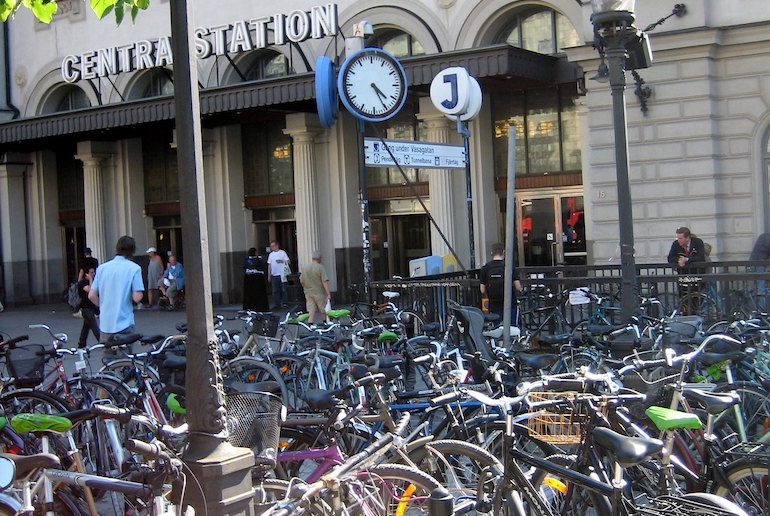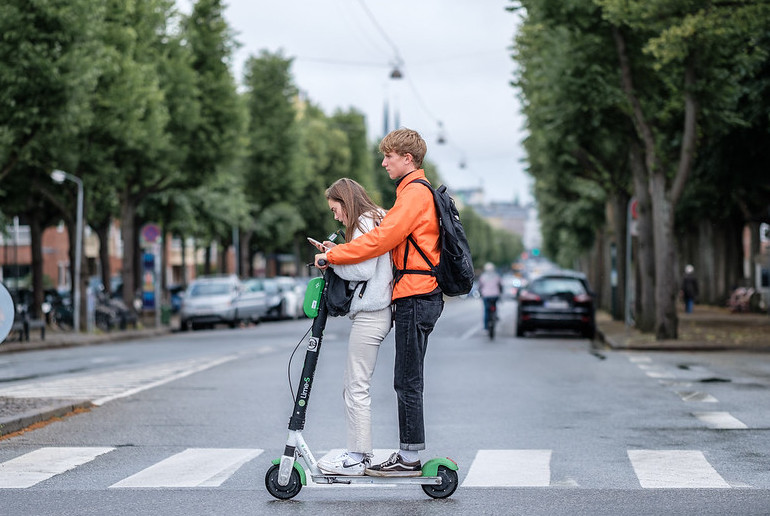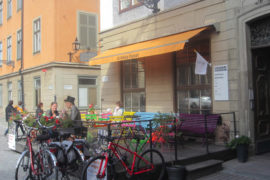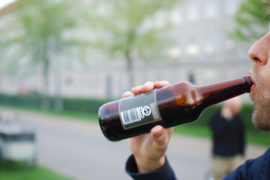The most enjoyable way to explore Stockholm is on foot. The oldest part of the city, Gamla Stan, is extremely compact, and lots of Stockholm’s main sights are within a half-hour walk of that neighbourhood.
If you start to get tired or want to strike out beyond the city centre, you can always let the public transport system take the strain.
Stockholm’s boats, trams, buses and subway trains are almost all operated by one company – Storstockholms Lokaltrafik (SL) – which means you can easily hop from one mode of transport to another. Scroll down for details on paying for journeys in Stockholm.
Tunnelbana (subway)
Buses
Trams
Ferries
Planning a route
Paying for tickets
Taxis
Bikes
Scooters
Walking
Tours
The tunnelbana (subway)
Stockholm’s tunnelbana, or T-bana, consists of three colour-coded lines. Stations are marked at ground level with a large ‘T’ and are dotted around the city centre.

Trains run from roughly 5am–1am each day, and provide one of the best options for getting around Stockholm.
One thing you’ll notice when riding the tunnelbana is the art covering the stations’ walls and ceilings.
We particularly like the blue leaf and flower motifs by artist Per Olof Ultvedt in the T-Centralen, which was the first metro station to feature art.
Another of our favourites is the animal sculptures, paintings and foliage in Tensta subway station, which were designed to remind immigrants of their home countries and celebrate the people of all cultures who live in Tensta.
Occasional free, guided art walks that describe some of the works in more detail are run in English and Swedish. All you need to attend one is a valid SL ticket.
Check the programme here to see if there’s a guided tour coming up.
Alternatively, you can download the SL ArtGuide app, which is an audio guide that tells you all about certain pieces of art at 21 central metro stations.
Or, click here for details of the art in 14 of the most beautiful subway stations.
Buses
For many journeys, especially if you’re heading out into the suburbs, buses are the best option. There are dozens of lines crisscrossing the city and the buses are generally clean and reliable, even when it’s snowing.

Ad Meskens (CC)
Press the yellow or red ‘stop’ button when you want to get off and the driver will pull over at the next stop.
Note that the buses we mention in the arrival section (for airports and ferry terminals) are privately run – you need a separate ticket to travel on them.
The buses also have an advantage over the metro in that they provide scenic views of the city. We particularly like route #55 from Kungsträdgården to Södra Station, which gives great views of the waterfront en route.
Trams
Trams only really serve Djurgården. There’s no subway service on the island so the trams provide a scenic alternative, linking central Sergels Torg with Waldemarsudde at the southern tip of Djurgården, passing a few excellent museums en route.
Ferries
Ferries are one of the joys of travelling around Stockholm, and there are three routes that are included on the SL network. Boats run from the city centre to the Stockholm archipelago, but there are also a couple of really useful city-centre lines that make it easy to hop between central islands.

The year-round Djurgården ferry (route 82) shuttles between Slussen (at the southern tip of Gamla Stan) and the island of Djurgården. Often, the same service also stops at a jetty on the eastern side of Skeppsholmen.
The Sjövägen 80 boat line connects central Nybroplan with Frihamnen in an almost-circular loop, stopping at Allmänna Gränd on Djurgården along the way. This route is handy if you want a quick way to get from the downtown area to the museums on Djurgården.
In addition, line 89 (Ekerö–Stockholm) shuttles between Tappström and Klara Mälarstrand, via Kungshättan, Ekensberg and Lilla Essingen.
Planning a route
To plan journeys by public transport in Stockholm visit SL.se – the service is available in English but the website can be clunky.
There is also an app for iPhone and Android that allows you to buy tickets quickly and easily – though if you’re doing a lot of travelling on public transport, it may be cheaper to buy a travelcard.
All the attractions we’ve listed in our Stockholm guide include details of the nearest subway station, bus stop, ferry dock or tram station.
Paying for travel in Stockholm
There are four ways of paying for travel on public transport in Stockholm; with a contactless debit or credit card; by the SL app; by a time-limited travelcard; or by individual single tickets.
★ SUGGESTED DISCOUNT
Save with the Stockholm Pass
Get up to 50% off at Stockholm's top attractions, including the Vasa Museum, SkyView Stockholm and The Viking Museum, plus discounts on some of the city's best boat trips.
By contactless card or digital wallet
For visitors who are only making a couple of journeys a day by public transport, the easiest way to pay is by contactless debit or credit card, which must be backed by Mastercard, Visa or American Express.
You can also use digital wallets such as Samsung Pay, Google Pay, Apple Pay and Fidesmo Pay.
The vast majority of stations on the tunnelbana have automated barriers, while buses, boats and trams have a reader that you need to hold your card over as you climb aboard.

Just tap your card or phone on the ticket reader as you start your journey, and the fare will automatically be deducted.
The default fare for a single journey is 39 SEK. Single tickets are valid for 75 minutes on all SL services.
To buy a discounted fare (26 SEK for students, seniors and children aged 6–19), you need to register your card details at least a day in advance on the SL website and change the category to discounted fare. The reduced fare will automatically be deducted.
The SL ticket app
First you need to download the SL ticket app, then enter the bank card details that you want to pay with.
For visitors who are only making a couple of journeys a day by public transport, the easiest way to pay is by downloading the SL ticket app, and entering the bank card details that you want to pay with.
Each time you want to use public transport, you buy a single-use ticket through the app (39 SEK; or 26 SEK for students, seniors and under-20s), which is valid for 75 minutes on all SL services.
Note that the time starts running out as soon as you complete the purchase, though you can change transport as many times as you like within the 75 minutes.
If you are planning to do more than four journeys within a day (that are longer than 75 minutes apart), you’ll find it better value to buy the day travelcard (see below).
You can also buy travel cards through the app (see below).
SL travelcards
If you plan to make more than four journeys a day on public transport, you’re best off buying an SL travelcard.
These are available in 24-hour (165 SEK; 110 SEK for students, seniors and under-20s), 72-hour (330 SEK; 220 SEK for students, seniors and under-20s), seven-day (430 SEK; 290 SEK for students, seniors and under-20s) and 30-day versions (970 SEK; 650 SEK for students, seniors and under-20s).
The cards are valid from the first time you touch in on a card reader on your first journey.
Travel cards and single journey tickets can be bought via the app or an electronic smart card. The reusable green SL smart card costs 20 SEK, and can be bought through the SL App, at metro and commuter rail stations and at ticket agents around Stockholm.
Single paper tickets
Single paper tickets can be bought from staff at ticket booths at metro and commuter rail stations, at staffed SL centres and at ticket agents. They cost the same as via the app or contactless card – 39 SEK.
The Stockholm Pass
Although the Stockholm Pass no longer covers public transport, it does include the hop-on, hop-off bus and boat which take you to many of the city’s main sights as well as a variety of boat tours and cruises to islands in the archipelago.
It also gives admission to many of the city’s top museums and attractions. To work out whether this is the best option for you, read our guide The Stockholm Pass: is it worth buying?
Taxis
Taxis are generally safe but a few dodgy drivers have given the industry a reputation for ripping off tourists, either by charging extortionate prices or driving around in circles to bump up the fare.
All taxis should display yellow stickers in their windows – the large number on the right represents the highest amount they can charge you for a 10km journey that takes 15 minutes.
It’s a crude way of allowing passengers to quickly compare prices before getting in. Our advice: only use taxis that display these yellow stickers, and ask for an estimate of the total price before you set off.
The taxi market is unregulated so don’t be afraid to ask around until you get a price you’re happy with.
Bikes
Stockholm is a great city for cyclists and dedicated bike lanes thread their way through the city centre.

There are also bike pumps dotted around the city if you need to pump your tyres up: this useful map shows you where they are.
Stockholm has loads of bike rental places: click here for some of more central ones. Or you can sign up for a guided bike tour of the city.
The city also runs an e-bike hire scheme – City Bikes – from April to October each year. Rates are a bargain 12 SEK for 24 hours, and 29 SEK for a week.
Scooters
Like many European cities, scooters are everywhere in Stockholm. Voi is the main operator, though you’ll also find scooters run by Lime, Bird, Bolt and Link.

Scooters are banned on pavements and pedestrian area, so you have to ride on cycle lanes or the road.
In order to pick up a scooter you need to download the app.
Prices vary according to each company, but Voi currently charges around 10 SEK to unlock the scooter, plus 2.50 SEK a minute.
Walking
If you’re happy walking, you might want to check out our nifty walking map – it shows the approximate amount of time it will take you to walk between each subway stop. You’ll be surprised by how quick it can be!
Renting a car
We wouldn’t recommend driving when you take inner-city journeys, but if you fancy taking a few day trips or want to explore further afield, having your own wheels can be very handy. Just make sure you rent a place with parking, as those charges can quickly spiral out of control!
Find a cheap rental car in Stockholm
To book a rental car before your trip starts and to pick it up when you arrive in Sweden, use the form below. It’ll search hundreds of local providers for you to find you the best deal.
Accessibility in Stockholm
On the whole the public transport system in Stockholm is pretty good for those with limited mobility.
Almost all metro, team and commuter train stations have platforms and trains at the same level, though wheelchair users will need to use ramps at commuter stations because of the gap.
All buses have level-floor access and carry ramps for wheelchair users.
For more detailed accessibility info, SL runs a 24-hour toll-free line (020 120 20 22).
Peak travel times
If you can avoid using public transport during rush hour you’ll have a more comfortable trip.
Around 8am and 4pm are peak times on the metro, with the T-Centralen station being particularly crowded.
In terms of sights and museums June, July and August are the busiest months, and weekdays are generally quieter than weekends.
Avoid public holidays too, if you can – for more on Sweden’s public holidays, click here.
Weather considerations
Stockholm’s weather is notoriously fickle. If you set out in bright sunshine, it’s quite likely to be pouring with rain within an hour or two or vice versa.
So, it’s worth checking the weather forecast before you decide on your method of transport. If it’s cold wet or snowy, you’re better off taking the metro rather than opting for a walking tour, bike ride or boat trip.
For advice on the best time to visit Sweden, read our guide.
Useful apps
There are several handy apps that can help with getting around Stockholm.
The SL app is the probably the most useful as you can plan your journey on public transport and buy tickets on it. It’s available in Android and Mac versions.
If you’re driving, Easypark (Mac and Android) identifies which parking zone you’re in and tells you how much you need to pay. You can also pay for and extend your parking time via the app.
Trafiken.nu Stockholm (Mac and Android) updates you on any traffic problems in the city and sends notifications if any traffic jams develop while you’re driving.
You can also order taxis via an app. Both Uber and Bolt (Mac and Android) operate in Stockholm.
Travis (Mac and Android) combines several forms of transport in one app. You can find the nearest electric scooter, bike hire outlet and metro station and buy public transport tickets through it.
And finally the Stockholm Pass app gives free access to loads of attractions, museums, boat tours and island trips.
Child-friendly tips
Generally speaking Stockholm is quite child-friendly. Children under 7 travel free on public transport, and those under 20 pay a discounted rate.
The MiniPass app provides tips for parents with young children, such as family-friendly activities, restaurants and attractions that are fun with toddlers and strollers.
Boat trips, the Skansen outdoor museum and the Vasa Museum are all good activities for young kids in Stockholm.
For more info on Stockholm for kids, see our guide.
Wifi availability
High-speed wifi is widely available in Stockholm, and it’s free for customers to use in most cafés and restaurants.
There’s also free wifi at the Arlanda airport, Central Station the Cityterminalen and the Stockholm visitor centre.
Public toilets
On the whole public toilets in Stockholm are clean and well-kept though you may have to pay between 5–10 SEK to use one.
To find the nearest public toilet in Stockholm and check whether you have to pay, download the free ToaSverige app (Mac and Android). It lists the most popular toilets, tells you when they were last cleaned and provides user reviews too!
Night transport
Most buses stop around 12.30am and the metro stops at about 1am, but there are several night bus routes in Stockholm that run between 1am–4.30am.
Night bus route #797 from Södertälje centre, via Brunnsäng, Rosenlund and Östertälje and #798 from Södertälje centre, via Geneta and Ronna to Hovsjö have flexible stops at night, so that people can get off where they feel safe even if it’s not an official bus stop.
Taking a tour
And if you fancy exploring Stockholm and its sights accompanied by a knowledgeable local guide, there are plenty of tours that will take you round the city using a variety of different types of transport.
By segway
Yes, this really is the most fun way of getting round Stockholm with its pretty parks, palaces and museums.

After a quick briefing, you’ll soon be whizzing around the island, led by a knowledgeable guide who’ll show you some of the city’s main sights including the Evert Taubes Terrace, the Royal Castle, and the Nobel Museum.
On foot
The best way to explore the Gamla Stan, Stockholm’s old town, is on foot. This guided walking tour gives you the low-down on the medieval city, taking in the Royal castle and telling you tales of historical blood baths, princes and dragons.
By bike
Do as the locals do and get round the city on two wheels with this three-hour guided bike tour. An English-speaking guide will show you famous sights such as Gamla Stan and the Kungsträdgården, and also take you off-the-beaten-track to explore less-visited parts of the city.
Bikes are included – all you need to do is turn up and pedal off!
By boat
Explore Stockholm’s beautiful waterways on a historic wooden boat. You’ll get to see the sights of the city from the water and go further afield around the pretty wooded islands of the Baltic Sea’s second largest archipelago.
FAQ:
Can I buy tickets on board the buses in Stockholm?
The short answer is no. You can’t buy tickets on board buses or commuter ferries, nor on most trams and light railways. But all buses, boats and metro stations have readers where you can tap in with your card (or simply use the app).
Are ferries included on SL tickets?
Three routes are included: route 82 between Slussen and Djurgården; the Sjövägen 80 boat line; and route 89 (Ekerö–Stockholm).
Can I take a bike on the ferries in Stockholm?
Some routes will take bikes, some won’t. Line 80 will accept bikes as long as there’s room, while line 82 is usually too busy, so will only take bikes at quiet times.
Line 89 has room for 30 bikes when there’s no ice (only 10 if Lake Malaren is icy), so is usually happy to take bikes.
See also:
Getting to Stockholm
Getting from Arlanda airport to Downtown Stockholm
110 Cheap and free things to do in Stockholm










